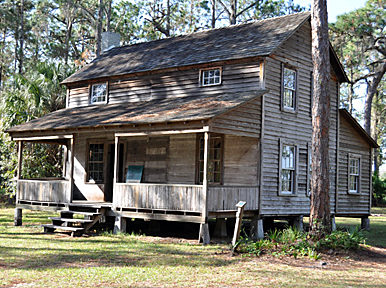Phone: 941-322-1000 | Email: [email protected]
Pioneer Village and Museum
The Museum at CMNC is the only air conditioned space on the property and receives a lot of visitors during the warmest parts of the day. Our pioneer museum exhibits a variety of historic objects, mostly from the Crowley family and the Old Miakka area. The museum is partially arranged like a general store, such as the one John Crowley and his son Jim had kept. A delightful cracker exhibit is in the museum as well. Here you will learn about the history of the "Crackers", view toys, tools and furnishings from the late 1800's and even see documents signed by past presidents. Don't forget to count the stars on the American flag on display! There is a generous display of farm tools and wheeled carts/wagons along the outside of the building as well to enjoy.
The Pioneer Cabin is a one room cabin typical of those built by pioneers when they first arrived to an unsettled area and contains furnishings and utensils that early pioneers would have used. Jasper Crowley built this cabin from wood reclaimed from his grandfather John Crowley’s cabin.

The Sugar Cane Mill and Kettle were used in a variety of ways, sugar cane was pressed in a mill and boiled in a kettle to create cane syrup or cooked down further to molasses, which could then be used to make taffy. The cane syrup could also be dried to create brown sugar.

The Tatum House is a star of this facility! This two-story house was built in 1889 by William H. Tatum and his two step-sons as the home for his wife and children. Over the years, the house was expanded to accommodate the couple’s thirteen children. One of the oldest examples of rural architecture in Sarasota County today, it was relocated to the Center in 1996 and restored to its 1892 appearance made possible, in part, by a grant from the Historic Preservation Society.

by Missy Brewer, who gratefully acknowledges Spessard Stone’s contribution of data on the life of Laura Fredonia Redd.
The c.1889 Tatum-Rawls House at Crowley is one of the oldest examples of pioneer Florida architecture still standing in Sarasota County. The building is a record of southwest Florida’s rural history. The Center’s volunteers have helped restore the house so that it may interpret history for future generations. Donations of period artifacts will make the house a home – typical of the period and region – once again.
Laura Fredonia Redd, born July 10, 1859, grew up on the expanding American frontier in Florida. She was the daughter of Elizabeth Redd, nee Elizabeth Brown and Isaac Alderman Redd, the first Baptist minister who settled in the area in 1867 and gave Bee Ridge its name. In marriage, the daughter became Laura Rawls, the wife of Sebern C. Rawls and the mother of five children. By her early twenties, she was a widow. In 1889, Laura moved into her new home built by her two children, Hilton and Charlie Rawls and her second husband, William Harvey Tatum, and the family enlarged the house in 1892.
The Tatum family had migrated to the area from Tatum, S.C. after the Civil War, some settling in what became Tatum Ridge. William H. Tatum, the son of one of these settlers, and Laura eventually had eight children together. After William’s death, Laura remarried taking Harvey Tatum, the builder of the Tatum house, as her second husband. He was born in 1863 and died of a stroke in 1924 at age 61. Laura lived in the house until 1945 when she then lived with her youngest daughter, Clara on Laurel Street in Sarasota until her own death on February 27, 1950 at age 92.
Rebecca Tatum Hull, daughter of Harvey and Laura Tatum, was a friend and neighbor of Jasper Crowley who donated the land now known as the Crowley so it is fitting that the house in which she was born is now restored and situated on the Museum grounds where Mr. Crowley spent so much time and effort to construct a display of the early settlers’ way of life. When Crowley acquired it, the house had been empty for nearly four decades and demolition was imminent. In 1996, a caravan hauled pieces of the building – roof, porches, house – from its original site near Proctor Road at 3 a.m. along quiet streets to a site at the Center which nearly duplicates its original setting among pine trees. Five years and $100,000 later, the Tatum-Rawls House was restored by volunteers and donors and with grant assistance.




